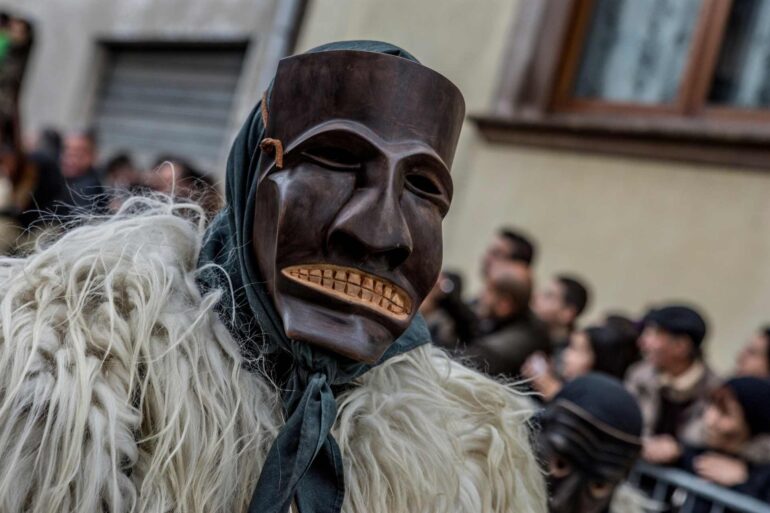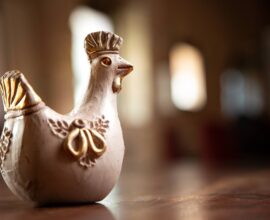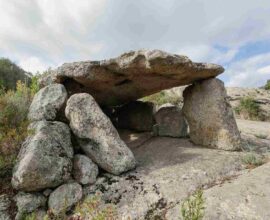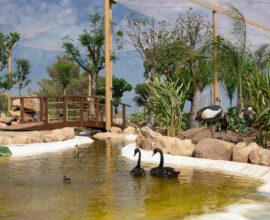Carnival masks and traditional sweets: a journey through customs and flavors of Sardinia
Celebrations of Carrasegare in Sardinia, with ancient Carnival masks and delicious sweets
Discovering all the fascinating masks that make the Sardinian Carnival unique and its traditional sweets, truly delicious in their genuine simplicity, that tell centuries of history and culture through unmistakable flavors and scents.
One of the best times to plan an unforgettable trip to Sardinia is certainly February, with its rich program of events and celebrations related to Carrasegare, Sardinian Carnival, which officially begins on the night of January 17th with the lighting of the bonfires of Sant’Antonio Abate. It is undoubtedly one of the most heartfelt and celebrated moments in the island, rooted in centuries of tradition, spirituality and folklore. A mix of influences that make it much more than a simple festival, but an experience involving all senses, an opportunity to discover ancient Carnival masks and a rich heritage of customs and traditions that make this celebration unique in the world.
During this period, the squares and streets of towns and villages are filled with mysterious and fascinating characters, such as Mamuthones and Issohadores from Mamoiada, in the innermost part of Barbagia di Ollolai, Nuoro area, wearing imposing masks and heavy cowbells and evoking stories of a distant time, with profound connection between man, nature and divine. Figures that, almost like coming from another world, embody a perpetual struggle between life and death, celebrating the rebirth of spring and the nature’s continuity.
Carnival, in fact, is not just a moment of transition, a great collective culinary celebration which precedes the coming of Lent, in which abstinence from earthly pleasures is in force, including meat (it’s no coincidence that “carnival” derives from the Latin expression carnem levare, or “eliminate meat”), therefore a moment for abundance and fun before the reflection and sacrifice that will characterize the next forty days of penance, but also a bridge connecting present and past of Sardinia, keeping the latter always alive in memory and culture through celebrations and customs plenty of sounds, scents and colors that embody the essence of the local identity.
In this scenario, the ancient Island of Ichnusa transforms into a living stage, and Carnival is a festive occasion, and a ritual, celebrating and strengthening the deep bond that unites the community with its history and traditions, highlighting a culture that resists and renews itself every year, without ever losing their own identity and features that have always distinguished it.
Adding a touch of sweetness to this festivity, the Sardinian Carnival sweets, rich in extreme simplicity and rusticity, made with genuine local ingredients, usually fried and covered in aromatic Sardinian honey or sugar. From the timeless Para frittus (or fried friars), soft fried donuts that warm bellies and spirits, to elaborate delicacies. Among the latter, zippulas, soft leavened dough made from semolina flour, milk and eggs (some recipes include potatoes or ricotta to make zeppole even softer and more delicious), flavored with orange peel, aniseed liqueur and, sometimes, saffron, then fried in oil or lard and sprinkled with sugar and honey, and the iconic mustazzolos, Sardinian version of mostaccioli, biscuits made from flour, sugar, yeast, cinnamon and lemon zest, with a glaze made of sugar, water and maraschino (or even orange blossom water for a delicate alternative), a very popular recipe throughout Central and Southern Italy. A true feast for the eyes – and beyond!
Sardinian Carnival masks: myths, origins and symbolism
Sardinian Carnival masks represent a rich and fascinating tradition rooted in ancient myths and beliefs, related to the protection of people and the land from evil forces. At the same time, each region in Sardinia boasts its own unique and characteristic way of celebrating the Carrasegare festival, keeping alive popular customs – hanging between sacred and profane within popular folklore – that tell about the deep island’s roots.
Whether it’s the Mamuthones and Issohadores from Mamoiada or the Boes and Merdules from Ottana, each traditional Carnival masks is a symbol of cultural identity, a bond between two distant worlds, the frenetic today and the contemplative past, which enriches Sardinian Carnival with profound meanings and rituals that still survive. Here’s some of the most popular Carnival masks from Sardinia, their origin and meaning.
Mamuthones and Issohadores from Mamoiada: myth of the clash between good and evil
Some of the most famous Sardinian Carnival masks are certainly Mamuthones and Issohadores, which come to life in the heart of Sardinia, in Mamoiada, in the mountainside land of Barbagia. Mamuthones, whose name derives from melaneimones, or “black faces”, an attribute given by Sardinians to Phoenicians, although the exact attribution of the term and the origin of this peculiar “disguise” is still a matter of controversy today, wear dark wooden masks (visera), while their body is covered with black sheep skins (mastruca), with bells (carriga) on the back. These are usually the “bad guys”, bearers of dark forces.
Issohadores, on the other hand, characterized by white masks, red bodices (curittu), white shirt and trousers, a bandolier of bronze bells (sonajolos) at the waist and coarse wool gaiters (cartzas), symbolize purity and light, positive element that balance the darker forces of their counterparts.
The dance of these figures, which takes place according to a precise arrangement of the two masks and peculiar moves, with Mamuthones proceeding more slowly and in silence, and Issohadores giving movement to the procession, is one of the key events of the Carnival of Mamoiada, an iconic clash between good and evil, between life and death, which ends with the rebirth of nature and the hope of good harvests.
Boes and Merdules from Ottana: the clash between man and beast
Just a few kilometers away is the town of Ottana, a place where one of the most mysterious and ancient Carnival traditions in Sardinia occurs: the Boes and the Merdules. Boes, scary masks covered in goat skins with horns resembling those of animals, represent the primitive force of nature, the wild power of beasts. Merdules, on the other hand, are masks that symbolize man, with traditional clothes that reflect rural life and the colors of earth.
The “dance” that involves these two figures tells of a ritual clash between animal instinct and human rationality, which symbolically represents the confrontation of natural forces, a metaphor for natural cycles and the conflicts between wild and civilized worlds, between chaos and order. This furious fight, however, is never completely destructive, but rather is an act of creation and renewal: man, who manages to dominate the animal force, prepares to live another year of prosperity and abundance, key themes in the Carnival rites celebrated in many cultures, even outside the Island.
Accompanying these two traditional Carnival masks there’s also Sa Filonzana, the one and only female character of the Carnival festivities celebrated in Sardinia (at least in a figurative sense, as in past women were forbidden to actively participate in these rites, so under the mask there was a disguised man), an elderly hunchbacked and lame woman dressed in black busy on spinning wool. There is a strong symbolism behind this Carnival mask: the thread represents life and the old lady is ready to cut it with a pair of scissors in front of anyone who doesn’t offer her a drink, a reference to the Roman Parcae (or Moire for Greeks).
During the festival, Sa Filonzana also witnesses the symbolic death of Boes, ordered to “die” by her authoritative voice, but who then get up after a few moments, ready to resume parading. A gesture that represents the resilience of life itself, which continually renews, just like the earth that comes back to life every year after its winter sleep. Sa Filonzana, with her disturbing and iconic features, therefore becomes mediator between the worlds of living and dead, connecting Carnival to a deep sense of renewal and continuity beyond time.
Sos Maimones from Ulassai: the gods of protection
Among the most widespread Carnival masks in Sardinia, Sos Maimones, also known as Maimulu, particularly bound to the Carnival of Ulassai, a village-museum in the middle of Ogliastra, central-eastern part of Sardinia. Sos Maimones, wearing their wooden masks with goat-like horns, are mythical figures halfway between man and animal, probably related to the cult of some proto-Sardinian deities, spirits that inhabited the mountains and the forest, who had a direct link with the wild primitive nature of the territory. Some think these figures represent Dionysus, Greek god of wine and “madness”.
In both cases, their ritual function remains the same, that is protecting the community from dangers, especially from diseases and natural disasters. Thus, even if the Sardinian Carnival is a time of celebration, its profound meaning still – once again – connects to the need to find a balance between man and nature and the higher forces.
Carnival of Tempio Pausania: the stake of King George
One of the most exciting events of Sardinian Carnival takes place in Tempio Pausania, in the heart of Gallura, where every year – since the distant eighteenth century – there’s the celebration of the “stake of King George” (Gjolgiu), an ancient mask, dating back to the pre-Roman era and symbolic sovereign of Carrasciali Timpiesu, who embodies the spirit of the land that bears fruit, to which dedicate sacrifices in a purification ritual promoting the whole community’s well-being.
The puppet of the king is accompanied by a parade of nice allegorical floats, carefully selected by a jury in the months preceding the event and each one inspired by a specific theme, often related to current events, while at the end of the procession begins the so-called “veglioni del Teatro del Carnevale”, with music, dances and many local delicacies. The Carnival in Tempio Pausania lasts six days, from Shrove Thursday to Shrove Tuesday (the day of the burning of King George), during which the entire town transforms into a real open-air stage, hosting cultural events and entertainment for adults and children.
The Sardinian Carnival is therefore much more than a celebration of masks and dances: it is a rite celebrating the connection between man and land, between material and spiritual. Carnival masks, with their symbolism, tell stories of protection, purification, fertility and rebirth, giving life to a Sardinia which feels alive in geography, in history, in mythology and traditions, handed down for generations. An invitation to ponder about the forces above us, that can be faced only by protecting the essence of the culture, through tradition.
Sweets of Sardinian Carnival: a triumph of authentic flavors, tradition and deliciousness
Carnival in Sardinia is not just about masks and ancestral rites, but an opportunity to celebrate the local gastronomic tradition, rich in sweets rooted in distant ages. Each area boasts its own delicacies, but they all share simple and genuine ingredients, such as honey, sugar, eggs, flour, and lard, delicious preparations usually fried and enjoyed with local liqueurs.
Among the most representative Sardinian Carnival sweets, zippulas (or tzìpulas) stand out, typical of Campidano, soft spiral-shaped leavened dough fritters, flavored with orange peel, sometimes enriched with filu‘e ferru (Sardinian brandy), served hot with a peculiar icing sugar, releasing an irresistible aroma. Another iconic dessert of the Sardinian Carnival are para frittus, soft donuts with a delicate citrus aroma, which differ from the former for their ring shape and for the softer and spongier dough, highly hydrated and well leavened, which gives it an almost impalpable lightness and the typical internal alveolation.
No less delicious are orilletas, also known as origlietas, orulletas or urigliettas, ribbons of sweet dough (durum wheat, eggs and honey), fried and dipped in honey, which take on a crunchy consistency on the outside and soft on the inside. Widespread especially in South Sardinia and in the historic regions of Baronia, Barbagie, Logudoro and Gallura, their preparation resembles – but certainly not their shape – the famous chiacchiere popular throughout whole Italy, although the addition of local honey makes them even more unique and delicious.
In addition to these delicacies, gatzas (also known as gathas or cattas), fritters made with a simple but tasty dough, based on semolina flour, water, lard and natural yeast (or brewer’s yeast). Their consistency resembles bread, especially when the dough includes boiled potato too, making them softer and lighter. The peculiarity of these fritters lies in their versatility: without sugar or eggs, they can be enjoyed both in a sweet version, by sprinkling sugar to enhance their fragrance, and in a savoury version, accompanied by cheeses, cured meats or typical Sardinian products.
Among the most delicious Carnival sweets, Uvusones, small fried dough morsels prepared with flour, sugar, butter, eggs and yeast. Their real peculiarity is the final touch: after frying, these delicious balls are filled with acacia honey and filu‘e ferru, giving them a unique and complete flavor. Finally, we cannot speak of Carnival without mentioning Arrubiolus, delicious fried ricotta balls covered by sugar or honey. Flavored with orange or lemon zest, they owe their name to the characteristic reddish shade they take on after frying.
Definitely, Sardinian Carrasegare is an experience that involves all the senses, and sweets are an essential part of this celebration. What better way to discover these delicacies than immersing yourself in the unique atmosphere of a trip to Sardinia at Carnival? With its fascinating masks, hypnotic dances and irresistible scents, this land will conquer everyone’s hearts with its authenticity and its extraordinary cultural heritage, made of ancient legends, ancestral rites and flavors that tell the story of proud people deeply bound to traditions.
Do you want to experience a fairytale holiday in an authentic paradise? Discover Forte Village Resort in Sardinia






